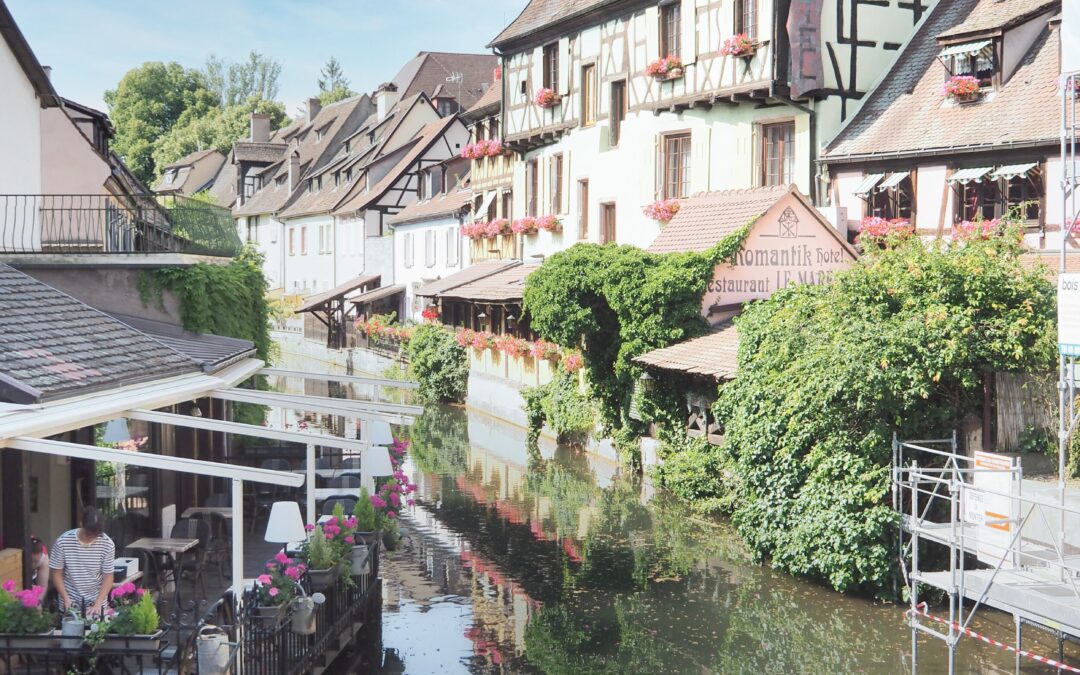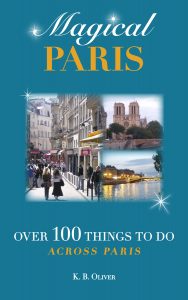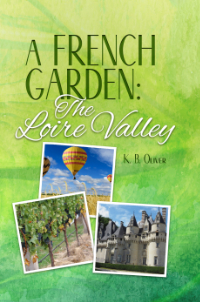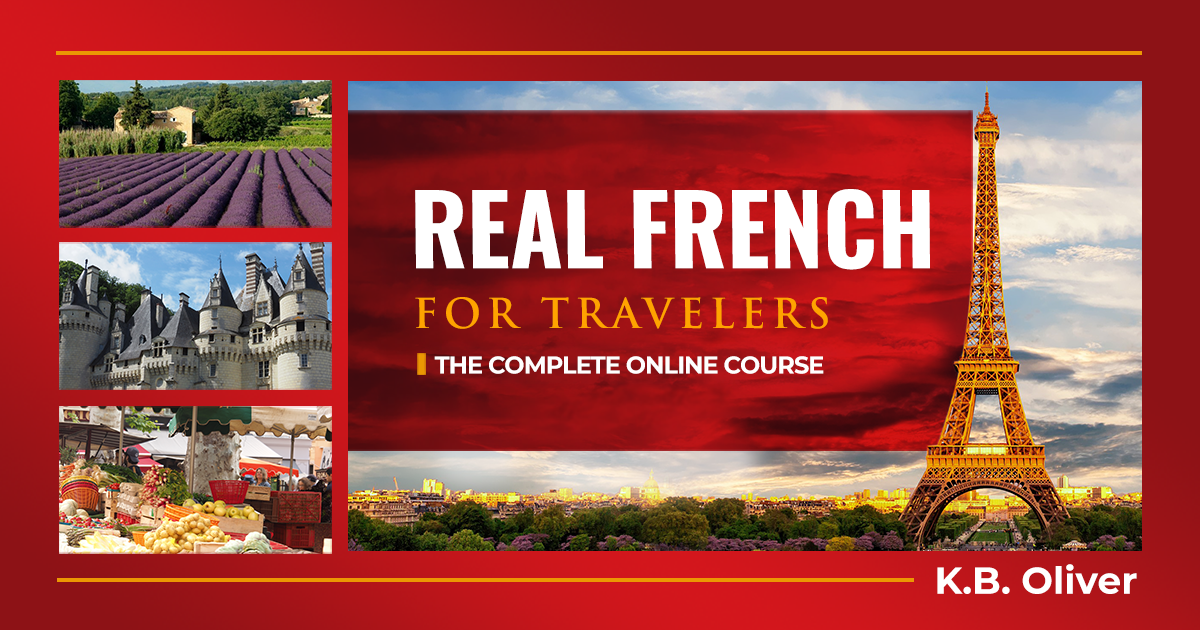Colmar, the Heart of Alsace
The Alsatian town of Colmar draws visitors to a storybook place rich with visual and historic treasures. Its canals, multitude of flowers, and half-timbered houses from centuries past charm travelers to this jewel in the east. Nearby are the Vosges Mountains and the Rhine River.
Though Colmar is smaller than Strasbourg, it’s larger than many of the quaint villages you’ll see on the Alsace Wine Route. You can easily spend more than a couple of days there.
Colmar is a worthy destination of its own, but if you’re planning to take the wine route, you’ll want to include it in your itinerary. (I have a post on a train itinerary that includes Colmar, so be sure to check that.) By car or by train, you’ll love this colorful town in the heart of Alsace. Despite 1000 years of history, it has been carefully preserved and restored.
Alsace, France
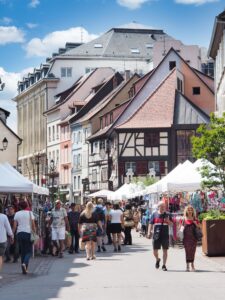 Alsace is a swath of land that borders Germany and Switzerland. Historically, its ownership bounced between France and Germany a couple of times. The Alsace region has its own wine, mostly white, with names like Gewürztraminer, Muscat, and Riesling. (Of course, you find those names in Germany as well, but Alsace puts its own flavor stamp on theirs.) The region is well-known for its unique cuisine, walking and biking trails, and especially the string of colorful towns a short drive from one another.
Alsace is a swath of land that borders Germany and Switzerland. Historically, its ownership bounced between France and Germany a couple of times. The Alsace region has its own wine, mostly white, with names like Gewürztraminer, Muscat, and Riesling. (Of course, you find those names in Germany as well, but Alsace puts its own flavor stamp on theirs.) The region is well-known for its unique cuisine, walking and biking trails, and especially the string of colorful towns a short drive from one another.
Getting There
From Paris to Colmar, there are 18 trains per day. Three of these are direct. The others stop in Strasbourg, so you can opt for a non-direct trip if you want to spend a few days in Strasbourg on the front end of your trip (or the back end), which I highly recommend. Both towns are wonderful yet different enough to enjoy. For a road trip, you can arrive in Strasbourg or Colmar by train, then rent a car to explore the other gems in this area. My book on road trips, Hit the Road in France: 9 Road Trip Itineraries Across France has more details on this region.
Highlights of Colmar
Of course, the Old Town is the heart and heartbeat of Colmar. You’ll want to spend most of your time here, where an abundance of shops, restaurants, cafés, and boutiques will keep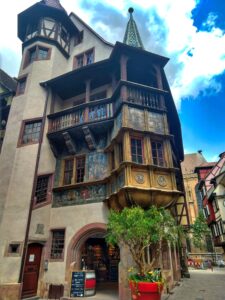 you busy. Along with that are museums, cathedrals, fountains, and canals…so much! Keep reading for ideas.
you busy. Along with that are museums, cathedrals, fountains, and canals…so much! Keep reading for ideas.
The Old Town is a large pedestrian zone. Follow a walking trail through the city to discover the main monuments, sectors, and places of interest. Maps are available at the tourist bureau (in Place Unterlinden. Open daily, 9 am to 6 pm. Closes at 1 pm Sundays.) While you’re there, ask about walking tours, guided tours, and the Colmar City Pass. The Pass includes 5 museums, the Little Train, and a boat ride for about 35€.
In “Little Venice”, you’ll see canals, flowerboxes, and many spots for the perfect photo. The Tanner’s district is known for white-fronted houses, and once hosted a lively tanner trade. The Gothic Collégiale de St. Martin is a cathedral that dominates part of downtown. Or you can visit (or take in a concert) at the Church of Saint Matthew.
The architecture in Colmar is fabulous, not only in its beauty and unusual features but state of preservation. Some buildings date to the 16th century and older such as the Adolph House (the oldest in the city, from the 14th century), and the Pfister House. The Old Customs House (Koïfhus, from 1480)is the oldest public building. The The Maison des Têtes, or “House of Heads”, from 1609, is so named for the 111 decorative faces on its façade. Many buildings as far as you can see in every direction burst with color and medieval charm.
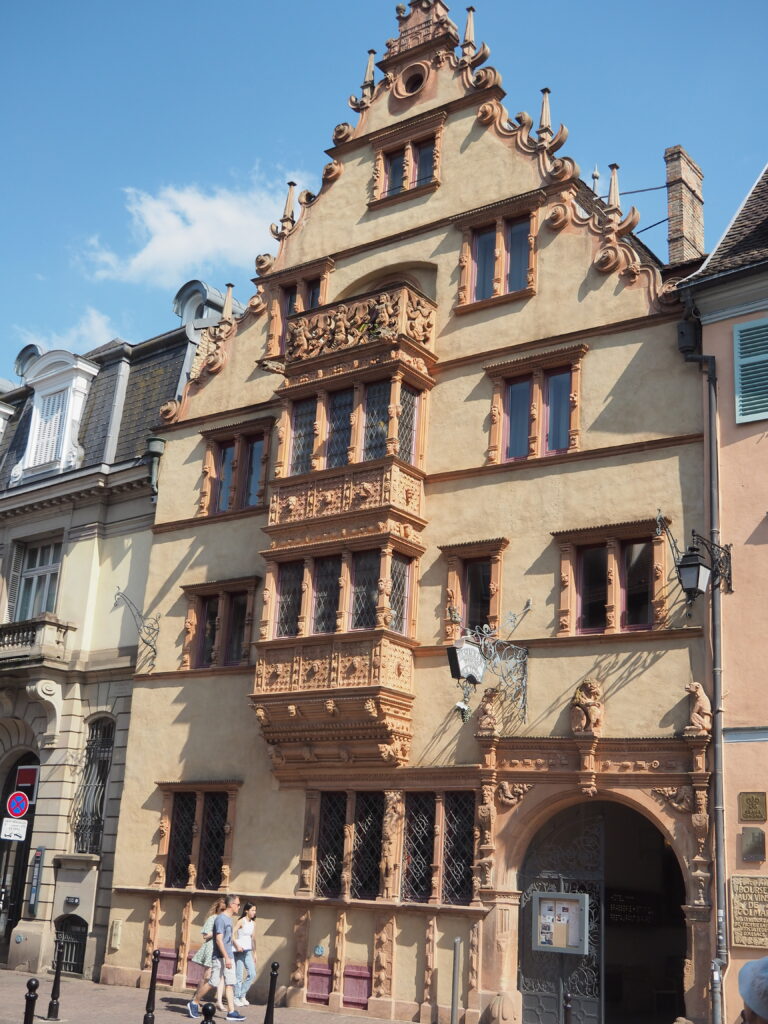
The House of Heads
Museums
A few (among others) for museum-lovers and those who love both beauty and learning!
The Unterlinden Museum (1, Place Unterlinden; open daily, 9-6, closed Tuesday.) houses fine art covering 7,000 years in what was once a 13th century convent. For more info on its collections: https://webmuseo.com/ws/musee-unterlinden/app/collection/expo/1?lang=en
André Malaraux: for contemporary art (4, Rue Rapp. Open Tues. to Sund, 2-6 pm. Opens at noon on Thursdays.) View creative and colorful contemporary works at this unique museum.
Musée Auguste Bartholdi: (30, rue des Marchands; open Tues. to Sun, 10-12 and 2 pm to 6 pm.))In the artist’s birthplace, you will learn more about his amazing sculptor whose work you may have heard of… like the Statue of Liberty, among others! Since his works are huge, the museum recounts facts of his life and shows many models of his work. It’s fascinating!
Musée des Vins d’Alsace (Alsace Wine Museum 12, Place de la Cathédrale; M-Sun. 10 am to 6 pm.) It covers the history of wine-making in Alsace narrated by an audioguide, and finishes with a chance to taste various samples and/or buy some.
Chocolate Museum: Musée Gourmand du Chocolat. A yummy way to learn! (12, Place de la Cathedrale; open Monday to Sunday, 10 to 6 pm)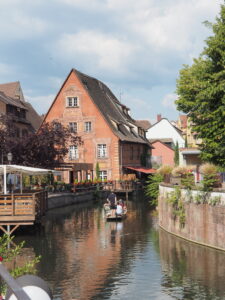
Folklore and Other Fun
From mid-June to mid-September, enjoy Alsatian folklore in the streets (with folks in traditional Alsatian costumes.) In the heart of the Old Town (near the Customs House), jump into a 100-year-old tradition.
Take the Little Tourist Train around Colmar to see more and preserve your legs too!
Visit a covered market (in a building from 1865) at 1, Rue des Ecoles, where over 20 merchants sell produce and other treats.
Take a flat-bottom boat trip with commentary along one of Colmar’s many canals.
If you’re in Colmar in December, don’t miss the Christmas Market. Alsatian Christmas markets are world-famous for a reason. There is plenty going on at this magical time of year. https://www.christmas.alsace/colmar-christmas-market/
Food recommendations: Kugelhopf (a traditional cake with raisins and powdered sugar), Tarte Flambee (also known by the Alsatian Flammekueche, is like a tomato-free pizza with a

variety of toppings.) Bretzels (like soft pretzels) and choucroute (sausage and sauerkraut.) Also, be sure to try some Riesling white wine from Alsace!
This is the way to discover the East of France!
Related Posts
A 10-Day Eastern France Train Tour
French Food Specialties: Normandy and Alsace

